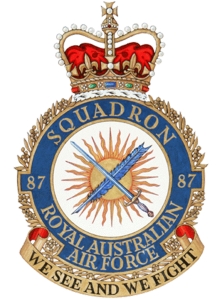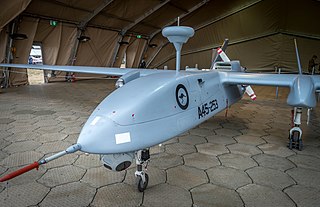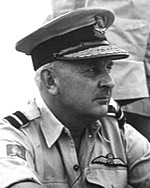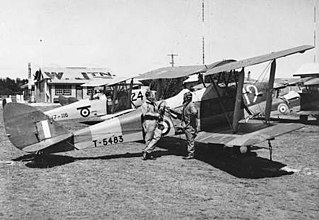
The Royal Australian Air Force (RAAF), formed in March 1921, is the aerial warfare branch of the Australian Defence Force (ADF). It operates the majority of the ADF's fixed wing aircraft, although both the Australian Army and Royal Australian Navy also operate aircraft in various roles. It directly continues the traditions of the Australian Flying Corps (AFC), formed on 22 October 1912. The RAAF provides support across a spectrum of operations such as air superiority, precision strikes, intelligence, surveillance and reconnaissance, air mobility, space surveillance, and humanitarian support.

The Australian Defence Force (ADF) is the military organisation responsible for the defence of Australia and its national interests. It consists of the Royal Australian Navy (RAN), Australian Army, Royal Australian Air Force (RAAF) and several "tri-service" units. The ADF has a strength of just over 85,000 full-time personnel and active reservists and is supported by the Department of Defence and several other civilian agencies.
The Airfield Defence Guard (ADG) mustering of the Royal Australian Air Force (RAAF) performs specialist ground defence tasks to protect air power assets from hostile ground action. The mustering is composed of non-commissioned members, commonly called 'ADGies,' most of whom are employed within a Security Forces (SECFOR) Squadron (SQN). Their primary role is the protection of RAAF equipment, personnel, assets and facilities during operations. While ADGs train to counter special forces as the primary ground threat to the projection of air power, ADGs are themselves conventional forces. Other duties include training RAAF personnel in weapon handling and basic ground defence tactics.

No. 28 Squadron was a Royal Australian Air Force (RAAF) Active Reserve squadron, based at HMAS Harman in the Australian Capital Territory. Its main role is public affairs and imagery. The squadron was formed in 1983 and disbanded in 2020.

No. 79 Squadron is a Royal Australian Air Force (RAAF) flight training unit that has been formed on four occasions since 1943. The squadron was established in May 1943 as a fighter unit equipped with Supermarine Spitfires, and subsequently saw combat in the South West Pacific theatre of World War II. Between June 1943 and the end of the war in August 1945 it flew air defence patrols to protect Allied bases and ships, escorted Australian and United States aircraft, and attacked Japanese positions. The squadron was disbanded in November 1945, but was re-formed between 1962 and 1968 to operate CAC Sabres from Ubon Air Base in Thailand. In this role it contributed to the defence of Thailand against a feared attack from its neighbouring states and exercised with United States Air Force units. No. 79 Squadron was active again at RAAF Base Butterworth in Malaysia between 1986 and 1988 where it operated Mirage III fighters and a single DHC-4 Caribou transport during the period in which the RAAF's fighter squadrons were transitioning to new aircraft.

No. 36 Squadron is a Royal Australian Air Force (RAAF) strategic transport squadron. It operates Boeing C-17 Globemaster III heavy airlifters from RAAF Base Amberley, Queensland. The squadron has seen active service flying transport aircraft during World War II, the Korean War, the Indonesia–Malaysia Konfrontasi, the Vietnam War, and the wars in Afghanistan and Iraq. It has also supported Australian humanitarian and peacekeeping operations around the world, including Somalia, Cambodia, East Timor and Indonesia.

No. 37 Squadron is a Royal Australian Air Force (RAAF) medium tactical airlift squadron. It operates Lockheed Martin C-130J Hercules aircraft from RAAF Base Richmond, New South Wales. The squadron has seen active service flying transport aircraft during World War II, the Vietnam War, the wars in Afghanistan and Iraq, and the military intervention against ISIL. It has also supported Australian humanitarian and peacekeeping operations around the world, including in Somalia, East Timor, Bali, Papua New Guinea, and the Philippines.
No. 292 Squadron is a Royal Australian Air Force (RAAF) operational conversion unit based at RAAF Base Edinburgh, South Australia. The squadron was formed on 1 January 1977 as the Maritime Analysis Training Squadron and renamed No. 292 Squadron on 27 October 1980. Throughout its history it has formed part of No. 92 Wing and been responsible for training aircrew to operate the RAAF's Lockheed P-3 Orion maritime patrol aircraft. It is also responsible for training Orion maintenance personnel.

No. 34 Squadron is a Royal Australian Air Force (RAAF) VIP transport squadron. It operates Boeing 737 Business Jets and Bombardier Challenger 604s from Defence Establishment Fairbairn in Canberra. The squadron was formed in February 1942 for standard transport duties during World War II, initially flying de Havilland DH.84 Dragons in Northern Australia. In 1943 it re-equipped with Douglas C-47 Dakotas, which it operated in New Guinea and the Dutch East Indies prior to disbanding in June 1946.

No. 87 Squadron is a Royal Australian Air Force (RAAF) air intelligence squadron. It saw action during World War II as a photo reconnaissance squadron, being raised in September 1944 through the re-designation of No. 1 Photo Reconnaissance Unit, which had been formed in June 1942. Throughout the war, No. 87 Squadron flew a variety of aircraft from bases in Australia, gathering photographic intelligence on Japanese forces and installations throughout the Pacific. At the conclusion of hostilities, the squadron was disbanded but was later re-formed in 1948, carrying out aerial survey operations in Australia until 1953. In 2006, it was re-raised again as a non-flying squadron tasked with air intelligence analysis as part of the Information Warfare Directorate within the RAAF's Air Warfare Centre.

Air Force Training Group is the Royal Australian Air Force (RAAF) group responsible for training personnel. It is headquartered at RAAF Williams, Victoria. The group was established as Training Command in 1953. It formed part of Support Command between from 1959 to 1990, when it was re-established as Training Command. In July 2006, Training Command was re-formed as Air Force Training Group under Air Command. Air Force Training Group consists of a headquarters and two Academies: Air Academy and Ground Academy.

No. 21 Squadron RAAF is a Royal Australian Air Force (RAAF) general reserve squadron. Formed in the mid-1930s as a unit of the part-time Citizen Air Force (CAF), it was mobilised for service during World War II, when it saw action against the Japanese as a fighter unit in the Malayan campaign, a dive bomber unit in the New Guinea campaign, and a heavy bomber unit in the Borneo campaign. After the war, the squadron continued to fly until 1960, when the CAF ceased flying operations. At that time, No. 21 Squadron converted to a non-flying support role, which it currently fulfils at RAAF Williams.

No. 25 Squadron is a general reserve squadron of the Royal Australian Air Force (RAAF). It is based at RAAF Base Pearce in Perth, Western Australia, and forms part of the Combat Reserve Wing. The squadron was formed in early 1937 and until early 1939 was designated as "No. 23 Squadron". During World War II, it provided local air defence for the Perth region, before undertaking Army co-operation duties in 1943–1944 and then converting to the heavy bomber role in 1945. In the heavy bomber role, the squadron took part in operations against Japanese targets in the Netherlands East Indies and supported Allied ground operations during the Borneo Campaign.
No. 26 Squadron RAAF is a Royal Australian Air Force Reserve squadron, headquartered at RAAF Base Williamtown in New South Wales, Australia. The squadron's role is to provide trained personnel to regular RAAF units during operations and on exercise.

Wing Commander Linda Mary Corbould OAM is a retired officer of the Royal Australian Air Force (RAAF), who was the first woman to command a RAAF flying squadron. She joined the RAAF in 1981, and became one of its first female pilots in the early 1990s. Corbould flew transport aircraft, including during the Iraq War in 2003, and commanded No. 36 Squadron from 2006 to 2008. She retired from the RAAF in 2011, but remains an officer in the Air Force Reserve.
No 27 Squadron RAAF is a Royal Australian Air Force (RAAF) reserve and ground support squadron located at RAAF Base Townsville, Queensland. The squadron was formed on 1 July 1981 to recruit and train RAAF reservists in the Townsville area and in July 2010 took on the additional role of providing support services to RAAF Base Townsville.

Air Commodore Raymond James Brownell, was a senior officer in the Royal Australian Air Force (RAAF) and a First World War flying ace. Born in Hobart, Tasmania, Brownell was working as a clerk with a firm of accountants when he enlisted in the Australian Imperial Force on the outbreak of the First World War. He served during the Gallipoli Campaign before transferring to the Western Front. Awarded the Military Medal for his actions during the Battle of Pozières, he was accepted for a transfer to the Royal Flying Corps in 1917. Brownell undertook flight training in the United Kingdom. Commissioned as a second lieutenant, he was posted for operational service over the Western Front in September 1917. Moving with his squadron to Italy, he was awarded the Military Cross and credited with shooting down 12 aircraft by war's end. Taking his discharge in 1919, Brownell returned to Australia.

No. 5 Flight was a Royal Australian Air Force (RAAF) aircraft flight which was equipped with IAI Heron unmanned aerial vehicles. It was established in 2010 to operate Herons in Afghanistan. Following the withdrawal of the Heron detachment from that country in 2014, conducted training missions in Australia to maintain the RAAF's expertise in operating unmanned aerial vehicles until more advanced types are delivered. The Herons were retired in June 2017, and the flight was disbanded by the end of that year.

Air Vice Marshal Alan Moorehouse Charlesworth, CBE, AFC was a senior commander in the Royal Australian Air Force (RAAF). Born in Tasmania, he graduated from the Royal Military College, Duntroon, and served with the 2nd Light Horse Regiment in Queensland before transferring to the Air Force in 1925. Most of his pre-war flying career was spent with No. 1 Squadron at RAAF Station Laverton, Victoria. In 1932 he undertook a series of survey flights around Australia, earning the Air Force Cross. Charlesworth's early wartime commands included No. 2 Squadron at Laverton, and RAAF Station Pearce in Western Australia. Appointed Air Officer Commanding (AOC) Eastern Area in December 1943, he was promoted temporary air commodore the following year and took over as AOC North-Western Area in Darwin, Northern Territory.

No. 7 Elementary Flying Training School was a Royal Australian Air Force (RAAF) pilot training unit that operated during World War II. It was established in August 1940 at Western Junction Aerodrome, Tasmania, and provided introductory flying training to new RAAF pilots. Training activities ceased in December 1944, and the unit was disbanded in August the next year.
















